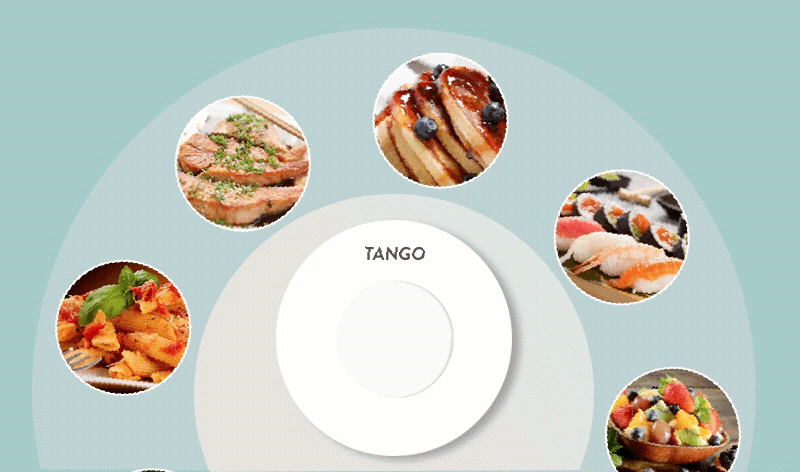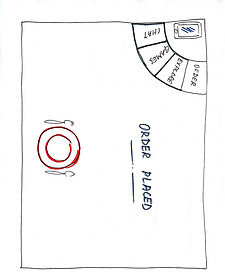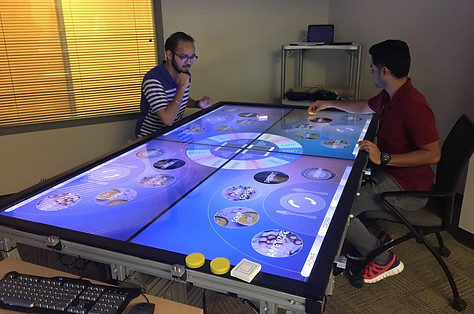

TANGO
A Tangible Table
Restaurant is a place where you have fun with friends, spend quality time with family, sell your ideas to employers, and meet the love of your life. However, the reality is cruel sometimes. You ordered the food you didn’t like due to the unclear menu, you missed your possible love in life because you didn’t find a good way to say hi. Your family and friends became the most familiar strangers because you ate with your phone. NO WORRIES! Tango is a tangible table here to revolutionize your dining experience!
Is This Your Dining Experience?

Go to restaurant with BFF
Find a booth
Order delicious food

Have interesting conversation during waiting time

Leave with satisfaction
Pay

Enjoy food!
"Nooooo!" all our interviewers answered
We are all familiar with restaurant environments where people eat and socialize. However, the experience in the restaurant could be improved. After interviewing our classmates, friends, and family, we found many problems existing in the restaurant scenario. The following are the main pain points:
-The menu is very confusing without indicating the ingredients. And it causes customers to order food they don't eat.
-When waiting for the food customers don't talk. Everyone plays with mobile phones without communication.
-Also, paying for the food is not an efficient process.
-Besides, customers sometimes wonder about the dishes on the other tables but feel embarrassed to ask.


Ideation
In order to revolutionize the customer experience. We have two goals in our mind:
-- Simplifying the whole process from order to pay
-- Creating quality time among friends and families in restaurants
Brainstorming


We brainstormed various ideas to improve the restaurant experience. These ideas are classified into four potential functions:
-- Order customized food
-- Play interactive games with your companion
-- Chat with other tables to inquire about their food or break the ice with a person who makes your heart race
-- Explore cool things in the city
Initial Sketches






We sketched out all ideas and critiqued the possible interactions. We found out that an interactive table could be a great idea to achieve the functions and our goals. Moreover, physical objects could be used to interact with the table and then enhance the user experience. In doing so, the cups, containers, and plates become part of the interactions, rather than the obstacles. Also, it will promote communication among customers as well as add fun to the dining experience. We named this table "Tango" where mugs and plates can "dance".
Prototype & Evaluation
Having the exciting ideas listed, we tried to vision interface and interactions with paper prototypes and physical prototypes. The prototype process and evaluation sessions provide us with great inspiration. Therefore, we were able to refine the design during the prototype sessions. We started with the "Order customization" feature in this project.
Paper Prototype
Put the phone on the table corner to start "Tango"


Use the cup to "flip" menu

Customize ingredients by rotating the containers



Finish ordering
Customers can click dishes to check reviews
Waiting with a progress bar
Feedback from the paper prototype walkthrough:
-- The vertical menu did not go well with the ergonomic design preferences.
-- Customers had difficulty reaching certain controls.
The solutions to the problems:
-- Design the menu in a circle surrounding the plate in front of the customer.
-- Rotate the plate to see dish options. This design makes the interaction more natural and keeps consistent with the mental model.
Physical Prototype
In order to validate the design, we created a physical prototype to mimic the real scenario. Random physical objects were employed as cups, plates, and containers. The physical prototype helped to make the flow clear. Meanwhile, more elements came up to contribute to a better experience.

Put your phone on the circle to start "Tango"

Support multi-users


Touch the table to choose service-Order
Rotate the objects to add an extra cheese
"Mugs" and "containers"
After the physical prototype walkthrough, we realized that a breadcrumb showing status and allowing customers to go back would be a helpful element. So we added this element to our High-Fidelity prototype.
Hi-Fidelity Prototype
We created the screens and interactive prototype, then imported them into the table display. During the evaluation, participants were required to simulate the interaction with objects. This quick prototype way allows us to iterate the design efficiently.



- Start "Tango" with your phone


- Tap "Order" to start ordering.
- Rotate the plate to browse the menu.
--Tap to enter the category
- Breadcrumbs on the bottom tell customers where they are and allow them to go back.


- Tap the picture to customize food
- Use cups and containers to choose the size and add/remove ingredients

-Finish order
-Waiting for the food with a progress bar
-Explore other features on the table
Evaluation
We conducted the evaluation sessions in a school lab using a think-aloud protocol. Participants were required to navigate through all the screens in their process and verbalize their thoughts as they move through the interfaces.
The participants were required to finish three tasks:
- Order a food item "muffin"
- Choose favor
- Adjust the quantity


Some of the key findings that emerged:
- Participants liked the idea of ordering food using the tabletop interface. They were quite fascinated by the look and feel of the interface and enjoyed playing and exploring all the options.
- The idea of showing the status of their food order was appreciated by the participants.
- Participants liked the concept of having games on the tabletop only if they were better than the games they already have on their mobile phones. Our prototype was not ready with screens for showing gameplay hence, we couldn’t test this feature.
Overall, people were happy with our design and they were really looking forward to the real product. However, there are many things to consider for further design. For example, kids may feel excited about the "magic table" so they only play with "TANGO" during dinner, which annoys their parents. The way using the mobile phone to start "TANGO" also has problems. What if people need to make a phone call? Have to put the phone there all the time? What if people don't have a mobile phone or forget to bring it? How to connect the phone and table? We are excited about "TANGO" and would like to explore its further version.